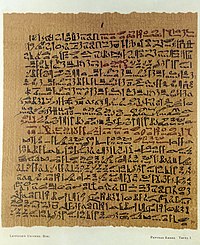
Back Египеттәи абызшәа Abkhazian Egipties Afrikaans ግብጽኛ Amharic Luengas echipcias AN اللغة المصرية Arabic لغه مصريه ARZ Llingües exipcianes AST Египеталъул мацӀ AV Misir dili Azerbaijani Егіпецкая мова Byelorussian
| Egyptian | |||||||
|---|---|---|---|---|---|---|---|
| |||||||
 Ebers Papyrus detailing treatment of asthma | |||||||
| Region | Originally, throughout Ancient Egypt and parts of Nubia (especially during the times of the Nubian kingdoms)[2] | ||||||
| Ethnicity | Ancient Egyptians | ||||||
| Era | Late fourth millennium BC – 19th century AD[nb 2] (with the extinction of Coptic); still used as the liturgical language of the Coptic Orthodox and Coptic Catholic churches | ||||||
Afro-Asiatic
| |||||||
| Dialects |
| ||||||
| Hieroglyphs, cursive hieroglyphs, Hieratic, Demotic and Coptic (later, occasionally, Arabic script in government translations and Latin script in scholars' transliterations and several hieroglyphic dictionaries[5]) | |||||||
| Language codes | |||||||
| ISO 639-2 | egy (also cop for Coptic) | ||||||
| ISO 639-3 | egy (also cop for Coptic) | ||||||
| Glottolog | egyp1246 | ||||||
| Linguasphere | 11-AAA-a | ||||||
The Egyptian language or Ancient Egyptian (r n km.t)[1][6] is an extinct Afro-Asiatic language that was spoken in ancient Egypt. It is known today from a large corpus of surviving texts, which were made accessible to the modern world following the decipherment of the ancient Egyptian scripts in the early 19th century. Egyptian is one of the earliest known written languages, first recorded in the hieroglyphic script in the late 4th millennium BC. It is also the longest-attested human language, with a written record spanning over 4,000 years.[7] Its classical form is known as “Middle Egyptian.” This was the vernacular of the Middle Kingdom of Egypt, and it remained the literary language of Egypt until the Roman period. By the time of classical antiquity, the spoken language had evolved into Demotic, and by the Roman era it had diversified into the Coptic dialects. These were eventually supplanted by Arabic after the Muslim conquest of Egypt, although Bohairic Coptic remains in use as the liturgical language of the Coptic Church.[8][nb 2]
- ^ a b Erman & Grapow 1926–1961.
- ^ "Ancient Sudan~ Nubia: Writing: The Basic Languages of Christian Nubia: Greek, Coptic, Old Nubian, and Arabic". ancientsudan.org. Archived from the original on 5 January 2009. Retrieved 9 March 2017.
{{cite web}}: CS1 maint: unfit URL (link) - ^ a b Allen 2000, p. 2.
- ^ a b Loprieno 1995, p. 8.
- ^ Budge, E. A. Wallis (1920). Egyptian Hieroglyphic Dictionary (PDF). London: Harrison and sons. Archived (PDF) from the original on 12 December 2017.
- ^ Loprieno 1995, p. 7.
- ^ Grossman, Eitan; Richter, Tonio Sebastian (2015). "The Egyptian-Coptic language: its setting in space, time and culture". 'Egyptian-Coptic Linguistics in Typological Perspective. De Gruyter Mouton. p. 70. doi:10.1515/9783110346510.69. ISBN 9783110346510.
The Egyptian-Coptic language is attested in a vast corpus of written texts that almost uninterruptedly document its lifetime over more than 4,000 years, from the invention of the hieroglyphic writing system in the late 4th millennium BCE, up to the 14th century CE. Egyptian is thus likely to be the longest-attested human language known.
- ^ Layton, Benjamin (2007). Coptic in 20 Lessons: Introduction to Sahidic Coptic with Exercises & Vocabularies. Peeters Publishers. p. 1. ISBN 9789042918108.
The liturgy of the present day Coptic Orthodox Church in Egypt is written in a mixture of Arabic, Greek, and Bohairic Coptic, the ancient dialect of the Delta and the great monasteries of the Wadi Natrun. Coptic is no longer a living language.
Cite error: There are <ref group=nb> tags on this page, but the references will not show without a {{reflist|group=nb}} template (see the help page).